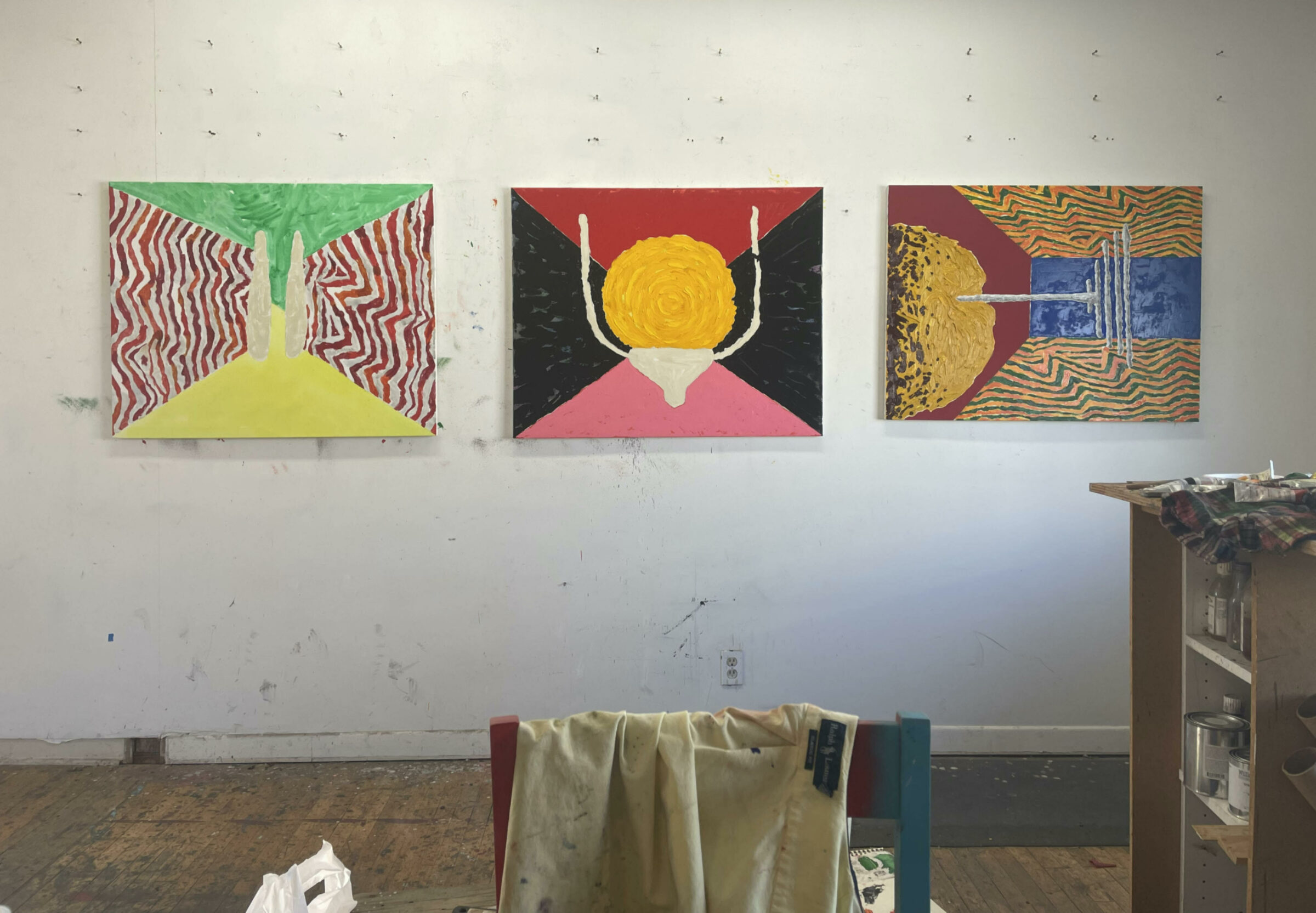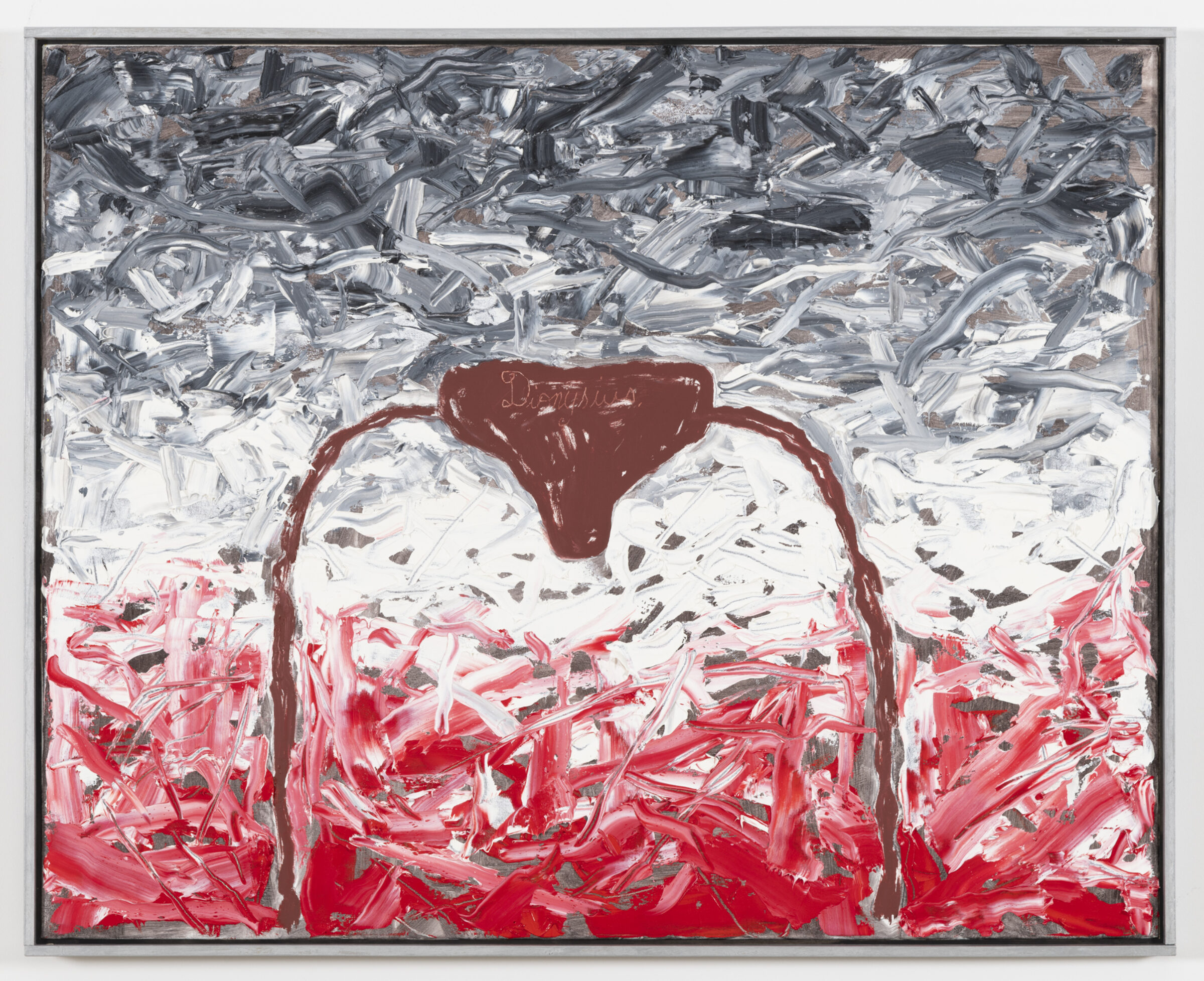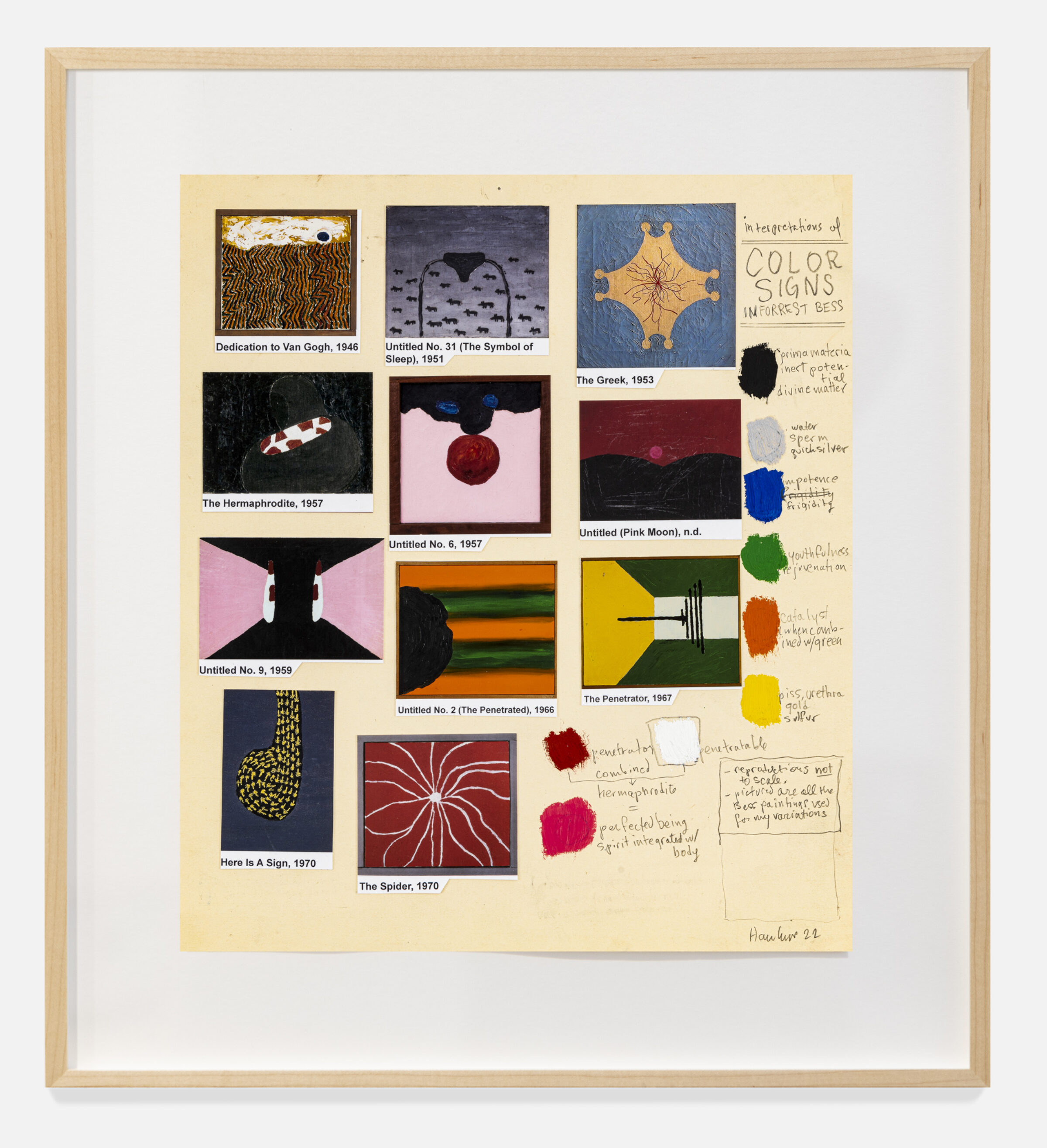Exhibition
Richard Hawkins
The Forrest Bess Variations

RICHARD HAWKINS
The Forrest Bess Variations

Richard Hawkins's studio, Los Angeles, Winter 2022
For his seventh solo exhibition at Greene Naftali, Richard Hawkins presents a new series of works that pay tribute to the self-taught artist Forrest Bess (1911-77). Bess found his way to painting after a stint in the army, as a therapeutic practice—a means of recording and coming to grips with the visions he experienced behind closed eyes at the edges of sleep. The potent, clarion images he saw in this preconscious state spurred a singular body of work, with biomorphic shapes and abstracted landscapes that lock the eye and rivet attention.
A bait fisherman from the Gulf Coast of Texas who showed with Betty Parsons and corresponded with Meyer Schapiro and Carl Jung, Bess tread a fine line between exclusion and access that eventually afforded him cult status in the art world. He died in relative obscurity but has since become a lodestar for contemporary practice—a painter’s painter who, for Ken Okiishi, continues to “emerge as a holy grail of glimmering and elusive marginality.” Hawkins’s own work often draws on historical precedent, channeling figures from Mike Kelley to Antonin Artaud; but Bess is the longest-standing object of his artistic fascination. Hawkins also hails from rural Texas and learned of Bess in a 1982 article in Texas Monthly, a longform profile by Michael Ennis that narrated a life of queer creativity in a place conducive to neither. There was a permission-giving power in this frank account of homosexuality and kink in a mainstream magazine, and Hawkins came to see Bess as a beacon or tether to the future he wanted for himself. “Whether consciously or not I gleaned from Ennis that art, discussions about art, and maybe even culture itself might one day be more open to the lives and works of misfits, autodidacts, perverts and rednecks like—if not Bess then—me.”

Forrest Bess with his work, 1960s. Betty Parsons Gallery records and personal papers, 1916-91. Archives of American Art, Smithsonian Institution.

Michael Ennis, “His Name Was Forrest Bess.” Texas Monthly (June 1982): 140.

Richard Hawkins, My Own Personal Bess. Kassel Fridericianum/Buchhandlung Walther König: 2020, p. 3.
“I was not even legal drinking age when I first read 'His Name Was.' But I can say with certainty that there was hardly a greater inspiration than Forrest Bess in my early evolution as an artist.”

Richard Hawkins
The Supreme Becoming, 2022
Oil on canvas on board
33 x 41 inches (83.8 x 104.1 cm)

Hawkins has repeatedly examined Bess’s oeuvre through his own lens, and The Forrest Bess Variations are his most recent interventions into the older artist’s iconic work. This latest group of paintings and works on paper typifies Hawkins’s exceptionally receptive, flexible approach, which studies and builds upon the ideas and methods of historical figures to renew his own.
Bess’s Untitled No. 31 was a flashpoint for Hawkins, among the first works he saw in reproduction—a field of four-legged stick creatures march toward a large, pelvic form that also resembles the head of a bull. Hawkins subjects that central motif to numerous reworkings: compositions are inverted or turned on their sides and backgrounds stripped away; colors are brightened or wholly reassigned, separate symbols fused into one. Hawkins’s iterative process moves beyond appropriation as faithful copying and research as due diligence, metabolizing Bess’s visual language and his thinking into something new. “The goal is really to initiate deeper understanding of his work,” Hawkins says, “and with it a deeper understanding of the level of engagement that I as an artist have in art.”

Michael Ennis, “His Name Was Forrest Bess.” Texas Monthly (June 1982): 142.

Richard Hawkins, pale red scar, 1984. Private collection.

Richard Hawkins
Legend, 2022
Collage, oil and pencil on paper
Paper: 14 1/2 x 12 1/2 inches (36.8 x 31.8 cm)
Frame: 19 7/8 x 18 inches (50.5 x 45.7 cm)
Alongside the paintings, Hawkins has included a collaged key to help decipher each abstraction, riffing on the idiosyncratic color theory that governed Bess’s work. Black in this formulation stands for inert potential, from which God made the universe; silver can be water (or sperm); yellow means piss/sulfur, green is rejuvenation. Hawkins’s Legend follows Bess’s lead in attempting to diagram the emanations of the unconscious: Bess’s letters include similar tables that annotate the personal lexicon of symbols that populate his paintings, over which he claimed to exert no control: “each [canvas] is a statement of what I don’t know,” he wrote to Betty Parsons, “I am only the conduit through which they pass.” Bess cast a wide net in his attempts to understand and interpret his work, and his charts synthesize deep reading of alchemy, mythology, Christian mysticism, and Carl Jung's theory of the collective unconscious, manifest in a set of primeval shapes that the mind somehow already knows.

Forrest Bess, Diagrams and Notes, undated. Meyer Schapiro papers, 1949-82. Archives of American Art, Smithsonian Institution.

Richard Hawkins
The Coming Together, 2022
Oil on canvas on board and artist’s frame
35 1/8 X 41 1/8 inches (89.2 x 104.5 cm)

Forrest Bess, Untitled No. 9, 1959

The title of Hawkins’s 2022 painting The Coming Together aptly describes his mediation of the work by Bess on which it’s modeled. In Untitled No. 9 (1969), two pendulous forms seem to pin back swathes of pink like parted curtains, leaving an hourglass of negative space in the center. In the Hawkins, those same red-tipped white ovoids have been thrust together, tightly paired rather than held apart.
Bess assigned gender identities to certain colors—red male, white female—and developed elaborate and life-altering theories of sexual difference, amassed over time in a now-lost thesis espousing the figure of the hermaphrodite as the key to eternal life. Through his notorious experiments with body modification, altering his own genitals to create a new opening, Bess personified the obsession with transformation that also animates his paintings—the undoing of binaries to achieve what Hawkins has called “the exquisite third.”
Bess never theorized the color pink, but Hawkins has articulated what he left unsaid: if the red and white forms read as male and female, “I believe that the pink field is the body of the hermaphrodite, the double-gendered and perfected future being.”

Richard Hawkins
Passage to Perfection, 2022
Oil on canvas
19 3/4 x 18 3/4 inches (50.2 x 47.6 cm)
Hawkins’s homages to Bess strike a balance between emulation and change, filtering the fundamentals through his own hand, taste, and extensive research. Bess originals are replicated, but never precisely, as Hawkins varies the palettes and flips orientations. His canvases also slightly shift Bess’s dimensions but retain their modest scale: “Most of Forrest Bess’s canvases rarely exceed a copy of LIFE magazine in size,” Hawkins notes—“miniscule next to the Persian rug size of most Ab Ex artists.” Bess’s cabinet pictures were ideally meant to be held in the hands, the better for viewers to engage and study them; Hawkins’s often fill the field of vision a bit more fully to hold gaze. The most evident sign of his intervention, though, is the appearance of ‘Dionysius’ on the surface of each painting: a misspelling of the Greek god Dionysus, lifted from one of Bess’s letters, and inscribed in a looping script reminiscent of Bess’s handwriting. The incursion of this element—extrinsic to the paintings—is a way of letting the research show, of extending Bess’s own lines of thought in directions he may not have fully pursued. Of the scrawled “Dionysius,” Hawkins says: “it’s in the work as a sign for the spirit guide that communicates between Bess and me. It might be his idealized super-self; it might be mine.”
"I have never said I was an artist. I have always considered myself a conduit to this phenomenon. The Creator behind me may be the Devil or it may be Dionysius."

Richard Hawkins
The Celestial Body, 2022
Oil on canvas on board
36 1/8 x 41 inches (91.8 x 104.1 cm)

Richard Hawkins, The Celestial Body, 2022 (details)


On the surface of each work, paint builds up in dense accretions, swiped on thick with a palette knife. Like Bess, Hawkins loads the work with far more paint than is needed to cover the canvas, placing emphasis “not just on the appearance of color but the substance of oil paint, its matter.” For him, the impasto in Bess’s work served a peculiar purpose: a way of capturing that which is inherently fleeting—a vision—through an excess of physicality. There’s an insistence to this surplus of paint that Hawkins sees as a kind of bid for our attention, a way of giving the eye more to latch onto in hopes that the experience of looking could be protracted.
“As Bess stresses in his letters many times,” Hawkins writes, “the more profound intentions of the work require that the viewer approach it with a meditative and open mind,” such that the contents of their own unconscious might “be revealed over several minutes of concentration.” Insular though Bess’s work may seem, with its runic symbols and philosophical rabbit holes, there is also a profound generosity in the ideal viewing situation he sought, which would use art as a means to come into fuller knowledge of the latent workings of the mind.

Richard Hawkins, Installation view, The Forrest Bess Variations, Greene Naftali, New York, 2022